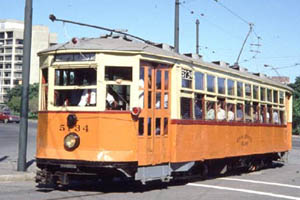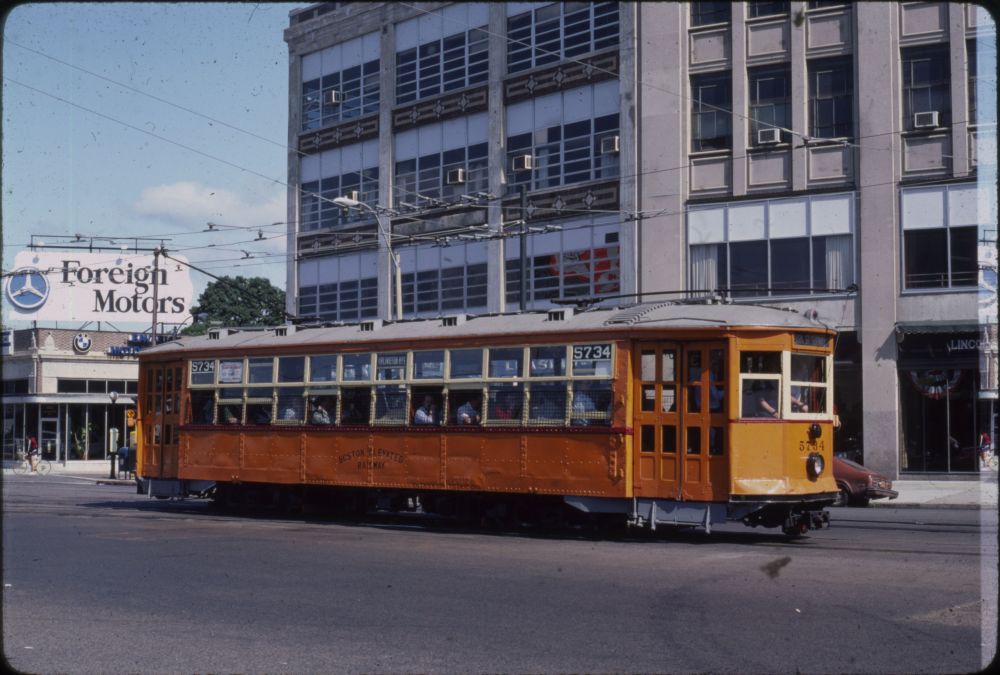
- Builder
- J. G. Brill Co.
- Description
- Semi-convertible, Boston 'Type 5'
- Secondary Use
- None
- Type
- City and Suburban Streetcars
- Year
- 1924
- Retired from Service
- 1959
- Acquired by the Museum
- 1959
- Note
- As of 2018, No. 5734 remains on display in Boston and is believed to be in operable condition.
Boston Elevated Ry. 5734
From Boston, Massachusetts
History
The Boston Elevated Railway, a private company, was formed in 1894 to build elevated lines in the Boston area. In 1897, the Boston Elevated also took over streetcar lines in Boston. In the 1920s, impressed with the cost savings afforded by the Birney car, but recognizing that it did not meet the needs of its routes, the Boston Elevated designed a double truck, lightweight car, similar to its earlier semi-convertibles, which met its needs. Like the earlier cars, these cars, designated Type 5, featured wide entry doors, large capacity and the capability to operate with either a one or two man crew. From the Birney car it inherited lightweight design, a low floor, and a high horsepower to weight ratio. Boston Elevated purchased 471 of the Type 5 cars between 1922 and 1928. No. 5734 came in 1924. The Type 5s replaced older, wooden cars.
The Type 5 cars provided the backbone of Boston’s streetcar service until after World War II when routes were converted to bus, trackless trolleys or the newer PCC streetcars. No. 5734 continued in service after 1947 when the Metropolitan Transit Authority took over Boston Elevated’s operation. After 1951, the MTA had a fleet of 321 single ended PCC cars which handled most of the streetcar service, but the MTA needed a few Type 5 cars to operate routes needing double ended cars. No. 5734 was among nine Type 5 cars remaining in operation until 1959. In 1958, the MTA bought eight double ended PCC cars from Dallas to replace the remaining Type 5s.
In 1959, Seashore acquired No. 5734. In 1954, Seashore had acquired Boston Elevated No. 5821 which is another Type 5 car very similar to No. 5734 but with a “vision front,” featuring narrower end posts and window frames to reduce obstructions to the motorman’s line of sight. When No. 5734 came to Seashore, the car ran in regular service and was later put in storage. In the 1960s, the museum repainted the car. To help mark the 20th anniversary of Boston’s Riverside streetcar line in 1979, Seashore leased No. 5734 to the MBTA (successor to the MTA) for $1 per year. No. 5734 was refurbished by Seashore before moving to the MBTA’s Watertown carhouse. The lease provided for the Boston Street Railway Association to use No. 5734 on charter trips over the Green Line. During the 1980s, the BSRA used the car on various trips, and Seashore volunteers continued refurbishment at the Watertown carhouse. When conversion of the overhead wire on the Green line was complete, making operation of the trolley-pole equipped 5734 problematic, the MBTA moved No. 5734 to display at the Boylston station and subsequently disconnected the track on which the car sits from the rest of the Green Line. The car’s roof structure cannot support a heavier pantograph current collector. No. 5734 last operated transporting dignitaries between Boylston and Park Street during the celebration of the 100th anniversary of America’s first subway in 1997.
Technical Information
- Seats: 48
- Control: K-71B
- Brakes: SM-3
- Compressor: DH-16
Trucks
- Number: 2
- Manufacturer: Standard
- Model: C-35P
Motor
- Number: 4
- Manufacturer: Westinghouse
- Model: 508A
Weight and Dimensions
- Length: 45’
- Width: 8’ 6.00"
- Height: 10’ 8.00"
- Weight: 31568 lbs.
Additional Images

In Boston on 6/07/81 in STM Library Collection
© 1998 - 2025 New England Electric Railway Historical Society. All Rights Reserved.